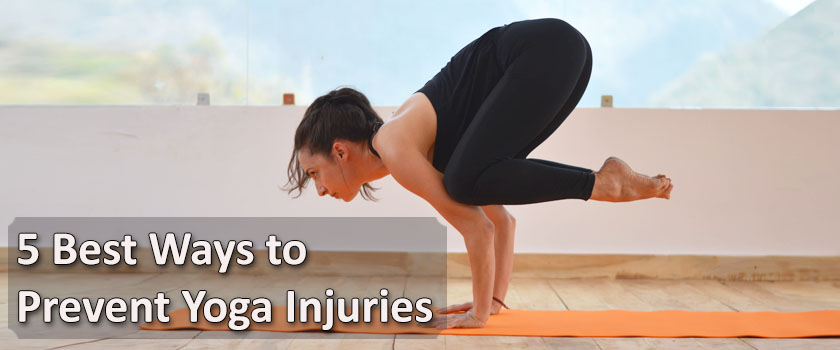
5 Best Ways to Prevent Yoga Injuries
Posted On : 10 February 2018.
Posted By : Yogi Mahesh Chetan.
Yoga is a science that has many healing properties and has many health benefits. If you have practised yoga, you might have loved the feeling when it takes the tightness away from your neck, loses your lower back, and increases your strength and flexibility. It reduces the stress level in the body effectively and raises the sense of spirituality in people's everyday lives. However, it is a practice that is often recommended as a therapy to recover from many injuries if you are careless, and yoga can also cause injuries, especially to your lower back, neck, and wrist. Hence, it is essential to practice yoga under certified yoga trainers. If you are considering enrolling in a yoga teacher training course in Rishikesh, you should be aware of these injuries as you will practice a lot of yoga daily.
Here we are diving you some of the most common yoga injuries and how you can prevent it:
Wrists: Injury on the wrist can happen when you put a lot of body weight on them. A lot of computer work and texting can lead to tender wrists, and if you are someone suffering from carpal tunnel syndrome. Wrist muscles and joints are the most commonly injured places during yoga.
All the time you go into downward dog pose, Chaturanga, and crow pose, your wrist takes a lot; practising it incorrectly can strain your wrist. Hence, to avoid injuries, it is necessary to spread your weight evenly on your finger, specifically between your index finger and the base of your hands.
Elbows: Joint pain usually results from elbows bending to the sides, primarily when you practice elbows-engaging yoga poses like Chaturanga. This can happen when you repeatedly try a pose incorrectly or overexert yourself. This repetitive stress can lead to elbows and shoulder injuries, so pushing your heels back when lowering your body and putting your chest forward is essential. Be careful when you are going into Chaturanga. Try to broaden your shoulder to minimize the risk.
Ribs injuries: Some yoga poses requiring you to twist may result in brushing the intercoastal muscles if not practised properly.
Neck injuries: It is the scariest place to get injured while practising yoga poses such as headstand and shoulder stand as it takes a lot of time to heal. Many inexperienced yogis rest on their heads and put a dangerous amount of weight on their necks while doing a full-wheel pose, shoulder stand, and plough pose. While doing these yoga poses, try to distribute your weight more on your arms and elbows beside your head and neck.
Lower back: The lower back is one of the most common things that get injured when you practice yoga. It can happen due to the spine's rounding while doing a forward bend and downward dog pose. The most common mistake practitioners make is that they keep their legs straight while going in a forward bend and round their back, which can cause injury in their sacral disc. Try to bend your knees a little and keep your back straight. This reduces the chance of injuring your lower back while practising.
Do not Exert Yourself Beyond your Limit:
The most common reason several yoga students get injured during their practice is that they push themselves beyond their limits. As the popularity of yoga is slowly increasing, the number of yoga students who do it for the wrong reasons is also increasing. If they see someone doing a challenging pose, they try and push themselves to do it better than that person.
However, here, you need to understand that yoga is supposed to be an exercise that is meant to improve a person's mind-body relationship. It would help if you never practised yoga by pushing yourself beyond your limit as this will result in a body revolt, which includes pulled muscles, torn hamstrings, busted knees or even broken necks.
Alignment:
If you do your alignment correctly in a yoga pose, that does not mean the same posture will be correct for another person. Besides, some people might even have restrictions on their muscles and joints. There can be emotional or mental restrictions as well. Therefore, all of these must be considered carefully.
Use the right Yoga Equipment:
Yoga requires a small investment in good equipment for yoga practitioners. Some may use already-owned items such as a towel instead of a yoga mat while practising yoga, but this can be a risky practice as the towel will be more prone to slipping than a mat. Therefore, buying a few bolsters and a yoga blanket can make a huge difference in safety and help attain the correct alignment and posture to prevent injuries.
Do not go for Yoga Classes which you think are too Advanced for You:
This is where many people end up getting yoga injuries. Many people need to look at the level they are comfortable in. If you are ready, opt for an advanced yoga class at the beginning. Therefore, it is essential for you first to determine your comfort zone and then, accordingly, join a yoga class that suits your needs.
Try to Locate a Good Yoga Teacher:
It is not always the student who is responsible for an injury. There are plenty of questionable yoga teachers who push their students too far. Instead of offering variations to a particular yoga posture, they urge those students to push through the pain and finish the position exactly as it is meant to be. Thus, finding a good yoga teacher at a reputable yoga class becomes significant. A good yoga teacher will teach you the proper yoga postures that suit your needs and will never force you to push your limits to complete a pose.
